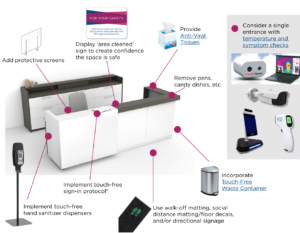According to the New York Post, 80% of employees would not feel safe returning to work upon re-opening. Organizations can implement best practices to ensure their employees feel safe when returning to the workplace. Developing a COVID-19 preparedness plan is key to having proper measures in place while setting the stage for workplace health and wellness. From protective shields and temperature checks, to touch-free restrooms and social distancing signage, welcome to the next way of working, let’s get started!
Categorizing your workplace into zones will help prioritize areas of focus:
• High traffic, high touch zone: Reception areas, restrooms, breakrooms
• Medium traffic, high touch zone: Workstations, conference rooms, elevators
• High traffic, low touch zone: Hallways, aisles
• Low traffic, high touch zone: Private office, print/mail rooms, file areas
First, focus on the high and medium traffic, high touch areas:
Temperature Checks:
• Are you incorporating temperature checks at entrances? Many organizations are and it is important to ensure your employees and visitors are safe. Taking this measure will inspire confidence when entering your workplace.
Cleaning Protocols and Guidelines:
• What are your cleaning protocols, and do you have guidelines? There is an array of cleaning solutions to consider. From UV disinfecting technology, to EPA registered cleaners and microfiber cloths, protocols such as ‘you touch it, you clean it’ are increasingly popular along with frequent hand sanitizer use. Locate sanitizer stations throughout the office, especially at the main entry and near workstations to promote cleanliness.
Touch-free Spaces:
• How touch-free are the spaces in your workplace? People are now hyper-aware of what they come in contact with and are mindful not to touch their face. We are confident touch-free solutions will stick after this pandemic. Hands-free door openers, touch-free soap dispensers and water faucets, and automated flush systems will be standard. Among the many studies conducted on air dryers, one found that they send out over 190 times more virus than paper towels (Washington Post). If it is the only thing you can do, replace air dryers with touch-free paper towel dispensers.
Air Purification:
• Have you considered air purification? According to the EPA the levels of indoor air pollutants are 2-5 times higher than outdoor levels! Air purification can eliminate more than 97.8% of pollutants and reduce risk of infection.

Signage:
• How will social distancing and cleaning guidelines be communicated? Many buildings have already added signage indicating that it has been properly cleaning and sanitized. This is just one of many ways to instill trust and make occupants feel comfortable when entering your workplace. You should also include informational signage to direct the flow of traffic, educate on hygiene etiquette, and maintain social distance. There are many ways to do this from custom decals, to freestanding whiteboard signs, and floor mats with 6-foot distance symbols.
Furniture & Design:
• How will your furniture layout be impacted? Employees have been working remotely in the comfort of their homes for some time now. Returning to the office can be overwhelming, especially in open office environments. Create a sense of safety by retrofitting, reconfiguring, and even repurposing what you already have. Adding protective shields or repurposing a mobile whiteboard to double as a shield, reorienting workstations so they are not face-to-face, and simply removing seats in your breakroom goes a long way to protect your team.
Video Conferencing:
• Have you heard of “Zoom fatigue”? Some of you have probably experienced it, here is one reason why along with tips. Research shows that when you’re on video, you spend most of the time gazing at your own face (HBR). The stimuli from your own video and backgrounds of others can be exhausting to keep your eyes on, try minimizing your video and consider using the speaker view. Lastly, schedule breaks between video conferencing and give your eyes a break during longer meetings by looking away or just listening in for part of it.
Work from Home (WFH):
• Millions of employees have followed stay at home orders and have been working from home to prevent the spread of COVID-19. A recent study by IBM found that nearly 55% of employees want to work remotely most of the time after the pandemic (Business Insider). Remote working is here to stay. Some companies are providing their employees with ergonomic furniture and accessories along with products to stay productive at home. Sit-stand desks, adjustable monitor arms, and task lighting are popular items!
Psychological Safety:
• On the flip side we know people have been significantly disrupted by this pandemic, and over 50% of survey respondents feel lonely working from home (USA Today). Some people want to remain working from home while others desperately want to get back into the office and are craving social connection. As employers we need to be aware of not only physical safety but psychological safety as well.
When I asked my CEO, Jennifer Smith, what does return to work look like for us she explained “As business leaders we are going to have to be flexible and give our employees choices as they determine their comfort level of when, if and how they return to the workplace.”
There is a lot to navigate as we prepare our return to the workplace. We understand there is not a ‘cookie-cutter’ solution which is why we strive to understand the goals of every organization. As you transition back to the office, we are here to make sure you are equipped with the proper workplace solutions needed in all areas of your business. With safety, wellness, and health being paramount, are you ready for employees to return to the workplace?

Kelly Link is a Workplace Strategy professional with a background in Interior Design. She is inspired by people and has a passion for problem solving with both qualitative and quantitative methodologies. She is committed to listening to user requirements, wants, and needs while working as a team to achieve a noteworthy solution. She is most passionate about consulting on interior environments that positively influence people’s health, well-being, behaviors, and experiences. Outside of work she serves on the CoreNet Midwest board of directors. She is a Certified Interior Designer, LEED Accredited Professional, WELL Accredited Professional, Fitwel Ambassador, and a Qualified Professional of Corporate Real Estate.
